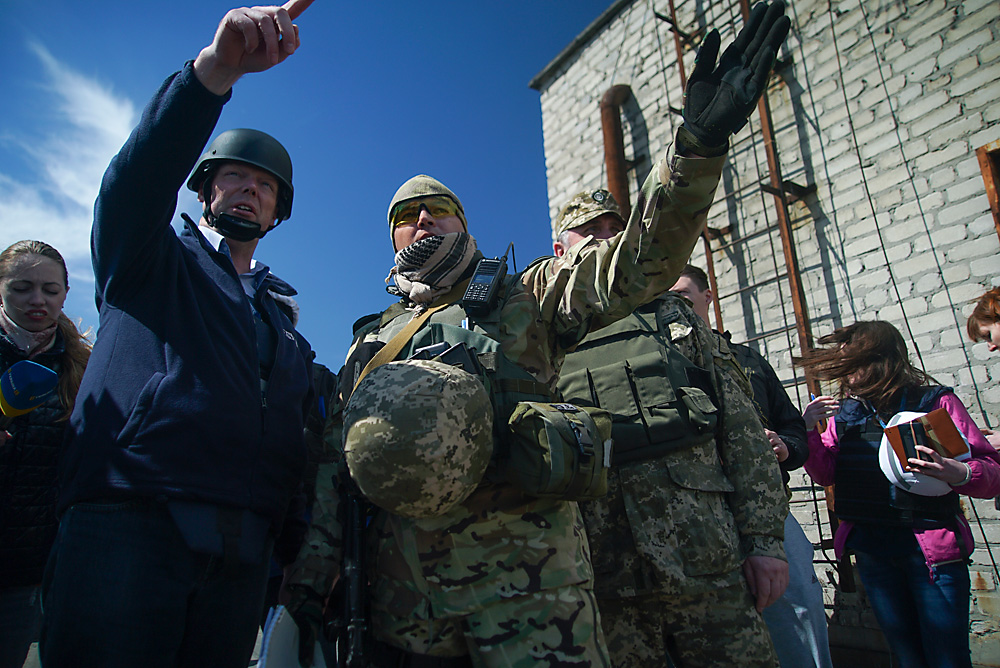
Alexander Hug, chief monitoring mission of OSCE in Ukraine (left) and Ukrainian military servicemen, members of Joint Center for Control and Coordination mission point at a side of the newly installed OSCE surveillance camera to register violations of ceasefire in Avdiivka, eastern Ukraine, April 16, 2016.
APOn April 24, in an interview with Ukrainian TV on April 24, Ukrainian president Petro Poroshenko expanded on proposals he had made earlier concerning foreign peacekeepers in the Donbass region of eastern Ukraine, where government troops have been fighting rebels from the Russian-backed self-proclaimed republics of Donetsk and Lugansk (DNR and LNR) since summer 2014. In his words, an OSCE police mission may be sent to the rebellious region.
The members of this mission will have to guarantee effective control of the line of contact. In the last months, despite the fact that there has not been any heavy fighting in the Donbass, there is still regular shooting and shelling and people are still dying, with both sides blaming each other.
According to Poroshenko, the OSCE will have to identify violations of the ceasefire. The mission's members will also have to organize armed posts in places where heavy weaponry is being removed, as well as in the part of the Ukrainian-Russian border in the Donbass that Kiev does not control, the part through which, Ukrainian and Western governments allege, Moscow is providing support for the rebels.
However, this will not be the mission's only objectives. The OSCE will also be involved in political regulation. The organization's collaborators will be responsible for holding elections of the "free and just" in the Donbass, as well as the "transference of power to the new representatives of the Ukrainian Donbass."
Poroshenko said that the U.S. and Ukraine's French, German and Russian negotiating partners back his idea.
In fact, on April 14 Russian President Vladimir Putin stated that he supports Poroshenko's proposal on "strengthening the OSCE's presence in the Donbass, including an armed presence."
But at the same time, just a little later in the evening, Presidential Press Secretary Dmitry Peskov clarified that the presence of OSCE forces in the Donbass must be agreed upon with members of the organization.
He also said that it is necessary to conduct "direct dialogue" with Donetsk and Lugansk, taking into consideration the opinion of the self-proclaimed republics.
Obviously such conditions are unacceptable for Kiev, which, since the very beginning of the conflict, has avoided direct dialogue with the rebellious regions. But these are not the only differences between Moscow and Kiev's approaches to the idea of armed OSCE representatives in eastern Ukraine.
In the opinion of Vladimir Mukhin, a military expert and commentator at the Nezavisimaya Gazeta newspaper, Putin and Poroshenko are speaking about completely different things.
The Russian president proposed to arm the present OSCE observers with the aim of self-defense, since the shelling has increased, while the Ukrainian leader is talking about "substantial forces that would impose peace upon the DNR and LNR governments and substitute them," said Mukhin.
According to Alexei Arbatov, member of the scientific council at Moscow's Carnegie Center, Poroshenko has a "vague picture of the character of this operation" and has proposed a "completely incoherent scheme."
In his words, it is unclear what Poroshenko had in mind: OSCE observers with small arms who could "protect themselves from bandits" or, in order to really separate the sides, are some kind of forces with heavy weaponry needed?
In a recent article, Arbatov proposed a plan to bring peacekeepers to the Donbass. He told RBTH that this proposal is basically an expansion of Putin's statement.
According to Arbatov’s plan, the region needs a full-scale peacekeeping operation with a UN mandate. The peacekeepers should be well armed, should have armored vehicles, artillery and helicopters and should be deployed along the line that separates the sides and not on all the Donbass territory, as would happen in the event of a police mission.
One of the key conditions for this plan's success, which, according to Arbatov, Poroshenko did not mention, would be the presence of Russian servicemen among the peacekeepers. Otherwise the peacekeepers will not be accepted in the self-proclaimed republics, which do not trust representatives of other countries.
All rights reserved by Rossiyskaya Gazeta.
Subscribe
to our newsletter!
Get the week's best stories straight to your inbox